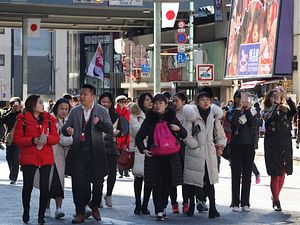China has an underappreciated foreign policy tool that it has used increasingly in recent years: tourism. When Beijing wants to punish countries that go against its foreign policy interests, it cuts off the flow of Chinese tourists. There is likely more in store, and it will be very hard to counter.
On April 10, 2012, Filipino and Chinese ships clashed over the disputed Scarborough Shoal in the South China Sea. Quickly, major Chinese tourism agencies suspended group travel to the Philippines. On May 10, the Chinese government suspended all travel to the country. By the end of May, Chinese arrivals into the Philippines were 54 percent lower compared to April. As late as January 2013, Chinese arrivals were still 42 percent lower than the prior year.
Since this trial-run, Beijing has gone after bigger targets with greater effect. In 2016, China targeted Taiwan following the election of President Tsai Ing-wen and her pro-independence Democratic Progressive Party. In 2017, it targeted South Korea after Seoul’s decision to deploy a U.S. anti-missile system that Beijing deemed threatening.
Cutting off tourism is a perfect tool for China, as it imposes real costs on targets. The tourism cuts cost South Korea up to $15.6 billion and 402,000 jobs. China already has the world’s highest spending on outbound tourism, and the numbers are expected to grow. The more Chinese tourists spend, the more damage Beijing will be able to impose in the future.
Cuts in Chinese tourism also cause political blowback for targeted governments. In Taiwan, more than 10,000 tourism workers took to the streets blaming Tsai for the decline in mainland Chinese business. Conversely, the blowback in China is small. Its tourists, after all, can simply head to different destinations.
Tourism cuts are also easy for Beijing to use. Chinese tourists are almost three times as likely to travel as part of package tours compared to other countries. This gives China far more control than it would have over individual travelers. It took almost no time for China to cut package tourism to South Korea. In January and February 2017, 130,000 Chinese tourists per month traveled to Korea through package tours. In March, the number was below 3,000, and averaged that for the rest of the year. While individual tourism also fell significantly, it was a more gradual process.
Other countries have noticed China’s tourism cuts and fear they might be next. Japan, for example, has a history of dealing with Chinese bullying. Following a 2010 confrontation over the contested Senkaku/Diaoyu islands, China stepped up restrictions on rare earth minerals exports, key inputs in many Japanese technology applications. In coordination with the United States and Europe, Japan mitigated the damage to its companies and brought a successful case against Beijing at the World Trade Organization.
Japanese officials take pride in their response to China’s bullying and consider themselves well-protected today. They note that when the islands dispute flared up again in 2012, China limited itself to encouraging popular boycotts against Japanese goods. They also note that China needs Japan as much as Japan needs China. In 2013, between 60 to 70 percent of Japanese exports were machinery and parts necessary for China to make its own goods.
Yet, some Japanese experts worry that Beijing could still target the country’s tourism flows. In 2017, China accounted for 26 percent of tourists to Japan. Redirecting them would be quick and painless for Beijing, less so for Tokyo.
To date, there have been few effective responses to tourism cuts. When faced with a Chinese boycott, Taiwan expanded promotional activity in Southeast Asia, lowered visa requirements for countries like Brunei and Thailand, and advertised its openness to Muslim tourists. In part, this strategy worked. Even though Chinese group tourists fell by 30 percent and Chinese tourists generally declined by 16 percent between 2015 and 2016, overall tourists grew by almost 300,000. However, the new tourists were not as high-spending as Chinese visitors, leaving an economic gap.
Without a convincing solution, China’s leverage will be in place for the next foreign policy crisis. For example, in Vietnam, another country with territorial claims conflicting with Beijing, Chinese tourists accounted for 30 percent of 2017 arrivals. These numbers would likely be salient if tensions between the two countries in the South China Sea escalate again.
Even the United States could be vulnerable. Tourism from China increased by 271 percent between 2010 and 2016, although Chinese tourists only account for 5 percent of total U.S. tourist arrivals. Yet, China’s global market power will only increase. Today, only 5 percent of Chinese citizens holds a passport. In the United States, the number is 40 percent.
To be sure, Washington can take some palliative measures. The United States and its allies could lower visa requirements to preemptively encourage tourism from a diverse set of countries, mitigating some potential costs. Policymakers could also authorize funds to compensate companies and countries targeted by these Chinese campaigns. Short-term assistance to the targets of coercion would force Beijing to choose between drawing out its tourism cuts or backing down and hopefully make Beijing think twice before acting.
The concern over tourists points to a broader unease in world capitals. Leaders are realizing that integrating China into global institutions has not restrained Beijing’s foreign policy impulses. The cuts are a stark reminder of China’s growing leverage and that, short of a shake-up of the global economic flows, foreign countries may be trapped as potential targets of coercion. If, as the recent U.S. National Defense Strategy notes, this is the era of “strategic competition,” China’s tourism cuts may be a tool with which the United States cannot yet compete.
Edoardo Saravalle is a researcher in the Energy, Economics, and Security program at the Center for a New American Security and the co-author of a new report, “China’s Use of Coercive Economic Measures.”

































